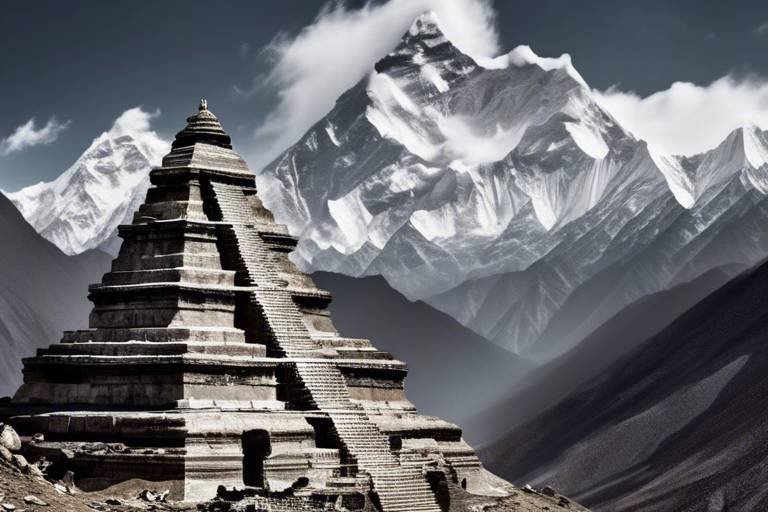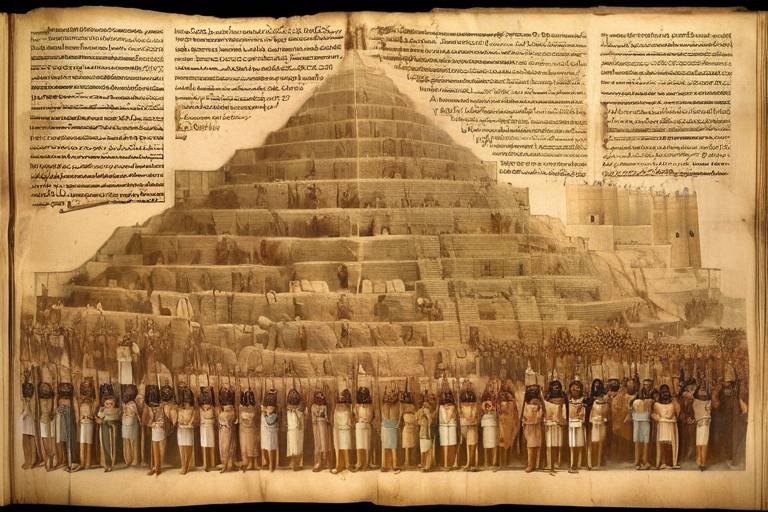The Enigma of the Lost City of Chichen Itza
Exploring the mysteries and historical significance of the ancient Mayan city of Chichen Itza, a UNESCO World Heritage site in Mexico that continues to captivate archaeologists and tourists alike.
Chichen Itza, a name that resonates with intrigue and wonder, stands as a testament to the ingenuity and mystique of the ancient Mayan civilization. Nestled in the lush jungles of Mexico's Yucatan Peninsula, this archaeological marvel has fascinated scholars and visitors for centuries. The very essence of Chichen Itza exudes an enigmatic aura, drawing in curious minds and adventurous souls alike, eager to unravel the secrets hidden within its ancient walls.

History of Chichen Itza
Exploring the mysteries and historical significance of the ancient Mayan city of Chichen Itza, a UNESCO World Heritage site in Mexico that continues to captivate archaeologists and tourists alike.
Chichen Itza, located in the Yucatan Peninsula of Mexico, holds a rich history dating back to the early Classic period of the Mayan civilization. Initially established as a major regional capital around the 7th century AD, the city flourished as a center of political, economic, and religious activity.
Over the centuries, Chichen Itza experienced periods of growth and decline, eventually falling into obscurity as the Mayan civilization faced internal turmoil and external pressures. The reasons behind the city's abandonment remain a subject of scholarly debate, with theories ranging from environmental factors to social upheaval.
Despite its eventual decline, Chichen Itza's legacy as a cultural and architectural marvel endures, attracting researchers and visitors from around the globe eager to unravel its enigmatic past.

Architectural Wonders
When it comes to the ancient Mayan city of Chichen Itza, the architectural wonders scattered throughout the site stand as a testament to the ingenuity and sophistication of the Mayan civilization. Among these marvels is the iconic El Castillo pyramid, also known as the Temple of Kukulkan, a towering structure that showcases the precise astronomical knowledge of the Mayans. The design of El Castillo is a stunning example of Mayan architecture, with each step representing a day of the Mayan calendar year and the serpent-like shadow that descends the pyramid during the spring and fall equinoxes, symbolizing the feathered serpent god Kukulkan's descent to earth.
Another striking feature of Chichen Itza is the Temple of the Warriors, a complex of stone columns and statues that pay homage to the Mayan military prowess and religious beliefs. The intricate carvings and sculptures adorning the temple depict warriors, priests, and mythological figures, offering a glimpse into the rich cultural tapestry of the Mayan civilization. Additionally, the Great Ball Court at Chichen Itza is a massive playing field where ancient Mayans engaged in a ritualistic ball game, showcasing not only their athletic abilities but also their spiritual beliefs and societal structures.
Exploring these architectural wonders at Chichen Itza is like stepping back in time to a civilization that thrived centuries ago, leaving behind a legacy of architectural excellence and cultural significance that continues to awe and inspire visitors from around the world. The intricate details, celestial alignments, and symbolic representations found in the structures at Chichen Itza are a testament to the advanced knowledge and artistic skills of the Mayan people, inviting us to unravel the mysteries of their past and appreciate the enduring beauty of their creations.

Significance of the Sacred Cenote
The Sacred Cenote, a natural sinkhole located at Chichen Itza, holds immense significance in the history and culture of the ancient Mayan civilization. This sacred pool of water was not only a vital water source for the inhabitants of the city but also played a central role in their religious practices and beliefs. The Mayans considered cenotes to be portals to the underworld, known as Xibalba, where gods and spirits resided.
Archaeological excavations around the Sacred Cenote have revealed a treasure trove of artifacts, including precious objects made of gold, jade, and other valuable materials. These offerings were believed to appease the gods and ensure fertility, prosperity, and protection for the community. The cenote served as a sacred site for ceremonies, rituals, and possibly human sacrifices, reflecting the Mayan's deep spiritual connection to water and the underworld.
The location of the Sacred Cenote within the ceremonial center of Chichen Itza suggests its integral role in the religious and social life of the city. Its proximity to important structures, such as the Temple of Kukulkan, indicates its association with the cosmological beliefs of the Mayans and their reverence for celestial bodies and natural elements.
The Sacred Cenote's significance extends beyond its religious and ceremonial functions to provide valuable insights into the daily lives and beliefs of the Mayan people. The presence of offerings and artifacts in the cenote underscores the importance of water as a symbol of life and renewal in Mayan culture, highlighting the interconnectedness of nature, spirituality, and community in the ancient world.

Mayan Calendar and Astronomy
The Mayan civilization is renowned for its intricate calendar system and advanced knowledge of astronomy, both of which are prominently displayed in the architecture of Chichen Itza. The Mayan calendar, known for its precision and complexity, consisted of various interlocking cycles that governed religious ceremonies, agricultural practices, and societal events. At Chichen Itza, the alignment of structures such as El Castillo with the movements of the sun during the equinoxes showcases the Mayan's deep understanding of celestial events and their significance in daily life.
Moreover, the Mayans' expertise in astronomy is evident in the precise positioning of buildings and temples at Chichen Itza to align with celestial bodies and mark important astronomical events. The observatory, known as El Caracol, demonstrates the Mayans' ability to track the movements of stars and planets with remarkable accuracy, allowing them to predict celestial events and agricultural cycles essential for their civilization's survival.
Additionally, the Mayans' intricate knowledge of astronomy intertwined with their religious beliefs, shaping the architecture and layout of Chichen Itza to reflect their cosmological worldview. The presence of astronomical symbols and alignments throughout the city highlights the Mayans' reverence for the heavens and their belief in the interconnectedness of the physical and spiritual realms.

Legends and Folklore
Legends and folklore are intricately woven into the tapestry of Chichen Itza, adding layers of mystery and intrigue to this ancient Mayan city. One of the most prominent legends is that of Kukulkan, the feathered serpent god, whose influence can be seen in the architectural design of El Castillo pyramid. The serpent's shadow descending the pyramid during the spring and autumn equinoxes is a testament to the Mayan's deep connection to celestial events and their sophisticated astronomical knowledge.
Another captivating tale surrounds the enigmatic disappearance of Chichen Itza's inhabitants. According to folklore, the city's residents vanished overnight, leaving behind a ghostly emptiness that still haunts the ruins. Theories abound, ranging from mass exodus to supernatural intervention, shrouding the city in an aura of enigma and speculation.
The Sacred Cenote, a natural sinkhole at Chichen Itza, holds its own share of legends. Believed to be a portal to the underworld, the cenote was used for sacrificial offerings to appease the gods. The echoes of ancient rituals still linger in its depths, echoing the spiritual significance it held for the Mayan people.
Legends and folklore not only enrich the historical narrative of Chichen Itza but also serve as a window into the beliefs and customs of the Mayan civilization. Each myth and story adds a layer of complexity to the city's legacy, inviting visitors to delve deeper into its enigmatic past and unravel the secrets hidden within its ancient stones.

Exploration and Rediscovery
Exploration and Rediscovery of Chichen Itza have been a journey filled with intrigue and excitement. The history of how this ancient Mayan city was initially uncovered by archaeologists and explorers reads like an adventure novel. From the first documented expeditions in the 19th century to the ongoing research efforts today, each discovery has unveiled new layers of the city's past.
Imagine venturing through the dense jungles of the Yucatan Peninsula, machete in hand, in search of hidden ruins shrouded in centuries of mystery and overgrowth. These brave souls, driven by a thirst for knowledge and a passion for uncovering the secrets of the past, risked life and limb to reveal the wonders of Chichen Itza to the world.
One of the most significant moments in the exploration of Chichen Itza was the groundbreaking work of archaeologist Edward Thompson in the late 19th and early 20th centuries. His meticulous excavation of the Sacred Cenote unearthed a trove of artifacts and human remains, shedding light on the religious practices of the Mayan people and sparking global interest in the site.
As technology advanced, so did the methods of exploration at Chichen Itza. Today, cutting-edge tools such as LiDAR scanning and 3D mapping allow researchers to delve deeper into the hidden corners of the city, revealing new insights into its layout, construction, and purpose.
The rediscovery of Chichen Itza continues to captivate the imagination of historians, archaeologists, and curious minds alike. Each expedition brings us closer to unraveling the enigmatic past of this ancient Mayan metropolis and preserving its legacy for future generations to explore and admire.

Modern-Day Visitors and Tourism
Modern-day visitors to the ancient city of Chichen Itza are greeted with a mesmerizing blend of history and mystery. As one of the New Seven Wonders of the World, this UNESCO World Heritage site attracts tourists from around the globe, eager to explore its enigmatic ruins and architectural marvels. The site's popularity has soared in recent years, with thousands of visitors flocking to witness the grandeur of structures like the El Castillo pyramid and the Temple of the Warriors.
However, with increased tourism comes the challenge of preserving the delicate balance between conservation and accessibility. Efforts to protect Chichen Itza from the wear and tear of foot traffic and environmental factors are ongoing, with strict regulations in place to ensure the site's longevity. Tourists are encouraged to respect the site's historical significance and follow guidelines to minimize their impact on the ancient structures.
Guided tours offer visitors a deeper insight into the history and significance of Chichen Itza, allowing them to unravel the mysteries of this ancient civilization under the guidance of knowledgeable experts. The allure of the site lies not only in its physical grandeur but also in the stories and legends that shroud its past, captivating the imagination of all who set foot within its ancient walls.
For many, a visit to Chichen Itza is a once-in-a-lifetime experience, a journey back in time to a world shrouded in myth and legend. The site's enduring appeal as a cultural and historical treasure continues to draw curious travelers seeking to unlock the secrets of the Mayan civilization and immerse themselves in the rich tapestry of its past.

Preservation Efforts and Future Prospects
Preservation efforts at Chichen Itza are crucial to safeguarding this ancient wonder for future generations. Various conservation initiatives have been implemented to protect the delicate structures and artifacts from environmental degradation and human impact. These efforts involve ongoing maintenance, restoration projects, and monitoring of the site's condition to prevent deterioration.
One of the key challenges facing the preservation of Chichen Itza is the impact of tourism. The influx of visitors to the site has raised concerns about the wear and tear on the structures, as well as the potential for looting and vandalism. Balancing the need to allow access for tourists with the imperative to protect the site's integrity remains a delicate task.
Future prospects for Chichen Itza depend on the ability to address these preservation challenges effectively. Continued research into innovative conservation techniques, sustainable tourism practices, and community involvement will be essential in ensuring the long-term survival of this cultural treasure.
Frequently Asked Questions
- What is the significance of Chichen Itza?
Chichen Itza is a renowned archaeological site in Mexico that was once a major regional capital of the Mayan civilization. It is known for its impressive structures, advanced astronomical knowledge, and rich cultural history.
- What are the architectural wonders at Chichen Itza?
Chichen Itza boasts remarkable structures like the El Castillo pyramid, the Temple of the Warriors, and the Great Ball Court, showcasing the architectural and engineering prowess of the ancient Mayans.
- What is the Sacred Cenote at Chichen Itza?
The Sacred Cenote is a natural sinkhole at Chichen Itza believed to have been used for ceremonial purposes, including sacrificial offerings. It provides insights into the religious practices of the Mayan civilization.
- What is the significance of the Mayan calendar and astronomy at Chichen Itza?
Chichen Itza features intricate astronomical alignments and structures that reflect the Mayan calendar system. This highlights the Mayans' advanced understanding of celestial events and timekeeping.
- What are some of the legends associated with Chichen Itza?
Chichen Itza is steeped in myths and folklore, including stories of the feathered serpent god Kukulkan and the mysterious disappearance of its inhabitants. These legends add to the enigmatic allure of the site.
- How has tourism impacted Chichen Itza?
Tourism has brought global attention to Chichen Itza, leading to its designation as one of the New Seven Wonders of the World. However, it also poses challenges in balancing preservation with visitor access and enjoyment.
- What conservation efforts are in place for Chichen Itza?
Various conservation initiatives are ongoing to protect Chichen Itza from environmental threats and the impact of tourism. These efforts aim to safeguard this cultural treasure for future generations.



















